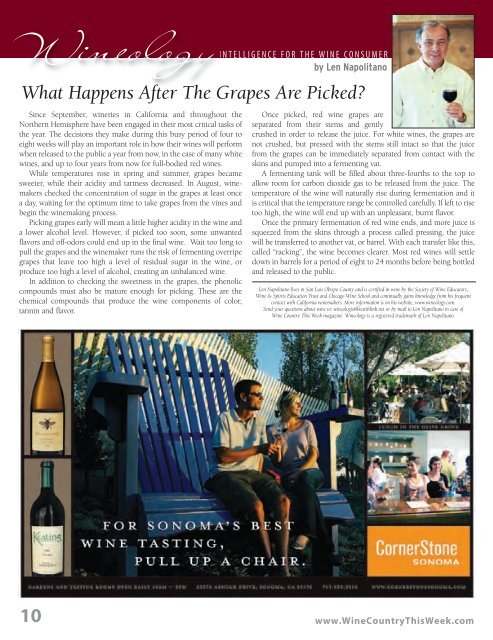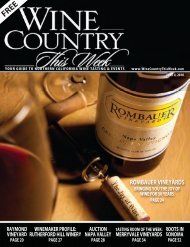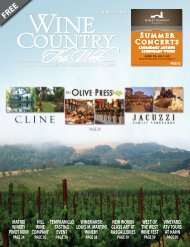View As PDF - Wine Country This Week
View As PDF - Wine Country This Week
View As PDF - Wine Country This Week
- No tags were found...
Create successful ePaper yourself
Turn your PDF publications into a flip-book with our unique Google optimized e-Paper software.
Since September, wineries in California and throughout theNorthern Hemisphere have been engaged in their most critical tasks ofthe year. The decisions they make during this busy period of four toeight weeks will play an important role in how their wines will performwhen released to the public a year from now, in the case of many whitewines, and up to four years from now for full-bodied red wines.While temperatures rose in spring and summer, grapes becamesweeter, while their acidity and tartness decreased. In August, winemakerschecked the concentration of sugar in the grapes at least oncea day, waiting for the optimum time to take grapes from the vines andbegin the winemaking process.Picking grapes early will mean a little higher acidity in the wine anda lower alcohol level. However, if picked too soon, some unwantedflavors and off-odors could end up in the final wine. Wait too long topull the grapes and the winemaker runs the risk of fermenting overripegrapes that leave too high a level of residual sugar in the wine, orproduce too high a level of alcohol, creating an unbalanced wine.In addition to checking the sweetness in the grapes, the phenoliccompounds must also be mature enough for picking. These are thechemical compounds that produce the wine components of color,tannin and flavor.I N T E L L I G E N C E F O R T H E W I N E C O N S U M E Rby Len NapolitanoWhat Happens After The Grapes Are Picked?Once picked, red wine grapes areseparated from their stems and gentlycrushed in order to release the juice. For white wines, the grapes arenot crushed, but pressed with the stems still intact so that the juicefrom the grapes can be immediately separated from contact with theskins and pumped into a fermenting vat.A fermenting tank will be filled about three-fourths to the top toallow room for carbon dioxide gas to be released from the juice. Thetemperature of the wine will naturally rise during fermentation and itis critical that the temperature range be controlled carefully. If left to risetoo high, the wine will end up with an unpleasant, burnt flavor.Once the primary fermentation of red wine ends, and more juice issqueezed from the skins through a process called pressing, the juicewill be transferred to another vat, or barrel. With each transfer like this,called “racking”, the wine becomes clearer. Most red wines will settledown in barrels for a period of eight to 24 months before being bottledand released to the public.Len Napolitano lives in San Luis Obispo County and is certified in wine by the Society of <strong>Wine</strong> Educators,<strong>Wine</strong> & Spirits Education Trust and Chicago <strong>Wine</strong> School and continually gains knowledge from his frequentcontact with California winemakers. More information is on his website, www.wineology.com.Send your questions about wine to: wineologist@earthlink.net or by mail to Len Napolitano in care of<strong>Wine</strong> <strong>Country</strong> <strong>This</strong> <strong>Week</strong> magazine. <strong>Wine</strong>ology is a registered trademark of Len Napolitano.10www.<strong>Wine</strong><strong>Country</strong><strong>This</strong><strong>Week</strong>.com
















